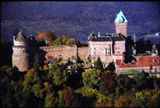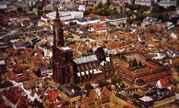The Alsace Region of France lies in the Eastern part of the country,
extending 110 miles from the German Border on the north to Switzerland
on the south and 30 to 35 miles across from the Rhine River on
the east to the Vosges Mountains on the west.The area is about
4000 square miles, 80 percent of the size of Connecticut. The
population is 1.7 million, about half that of Connecticut.
Principal cities are Strasbourg, Colmar, and Mulhouse. The Region
is rich in industry and agriculture.The vine covered slopes extending
nearly 60 miles along the foothills of the Vosges Mountains are
one of the best wine growing areas in France.
The history of Alsace has been an intertwining of German and French cultures and influences. It is difficult to establish the exact date of the appearance of the first man in Alsace. There is evidence that primitive man struggled to survive there as early as 10,000 B.C. Between 4000-3000 B.C. the inhabitants were farmers who settled on the fertile lands of middle Alsace.
 About 300 B.C. Celtic tribes arrived from the Danube Area and
settled on the fertile plains where they engaged in agriculture,
stock breeding and trade. The area became known as Gaul. To
defend themselves from attack by the Germanic tribes to the east,
they built fortifications both on the plain and in the mountains.
About 300 B.C. Celtic tribes arrived from the Danube Area and
settled on the fertile plains where they engaged in agriculture,
stock breeding and trade. The area became known as Gaul. To
defend themselves from attack by the Germanic tribes to the east,
they built fortifications both on the plain and in the mountains.
Roman legions defeated the Germanic tribes in 58 B.C. Thus
began a struggle between the Romans and Germans for control of
the region that would last for centuries. Roman civilization
spread rapidly. In 14 A.D. the Emperor Tiberius established a
legion camp at Argentoration near what is now Strasbourg. A network
of roads including links across the Vosges, connected Alsace to
the Roman Empire.
Franks and Alamanni tribes crossed the Rhine in 260 A.D. and
were defeated by Claudius II. The area was under constant threat
of invasion by the Franks during the fourth century. With the
introduction of Christianity by Constantine, missionaries began
converting the population. Diocese were established that would
have a strong influence on future political boundaries.
Early in the fifth century Rome withdrew its troops from Alsace
and barbarian invasions and civil wars began. Attila and the Huns
invaded in 451. Alsace was integrated into the Kingdom of the
Franks in 496 A.D. Charlemagne the Great became King of the Franks
in 768 beginning a reign of peace and prosperity. Following Charlemagneís
death Alsace was caught up in a series of quarrels over succession
which resulted in Alsace becoming a part of The Eastern Frank
Kingdom of Louis the German in 870 A.D and the next 800 years
France remained a part of the German Empire.
 Alsace flourished from 900 to 1250 AD with the new Christian
religion and the construction of abbeys , cathedrals and castles.
Haut Koenigsburg, situated high above the Rhine Valley at Chatenois,
was constructed during this period. Completly restored at the
turn of the century, the castle is today Alsaceís most
frequently visited attraction.
Alsace flourished from 900 to 1250 AD with the new Christian
religion and the construction of abbeys , cathedrals and castles.
Haut Koenigsburg, situated high above the Rhine Valley at Chatenois,
was constructed during this period. Completly restored at the
turn of the century, the castle is today Alsaceís most
frequently visited attraction.
The fourteenth century , marked by sickness, famine and political
instability, brought devastation to Alsace. The region began
to divide into urban and rural factions. A new and wealthy middle
class arose in the cities, the bourgeois. This class of merchants
and craftsmen organized and supported powerful guilds. They soon
began to rival the upper classes and aristocracy who controlled
the rural areas.
The ruling dynasty recognized the powerful guilds as a way to
defy the clerics and aristocrats both controlled by Rome. The
Emperor Frederick II promoted many towns to Free Imperial City
status. In 1262 Strasbourg declared its independence from the
Bishop and become an Imperial City. The cities became all powerful
and banded together into the Decapolis, a league of cities, in
the mid 1300's.
Free from the yoke of the Catholic Bishops, protestantism began to flourish in the cities in the fifteenth century. Strasbourg became Lutheran and Mulhouse became Calvinist. The peasants had had enough of being the victims of petty rivalries and hard times. A conspiracy, fueled by religious differences took place in 1491. The rebellious peasants were eventually suppressed. By 1521, however, the reformation had spread throughout Alsace.
A Seigneurial System came into being in France and surrounding duchies during the Middle Ages. Seigneuries were tracts of land given to noblemen and rich merchants called seigneurs. The seigneurs rented sections of their land to the peasants who made their living farming the land. They paid a small rent, performed military service when needed, and worked a few days each year without pay for the seigneur.
The Duke of Lorraine granted such a Seigneury in Northern Alsace at Tanviller, This author has not determined exactly when the tract was granted, but it is known that the Seigniory was in existence in the early 1500s. The The territory of the Seigneury of Tanviller included all of the present day village of Thanville parts of St Pierre Bois and St Maurice, and the hamlet of Hundswiller that was destroyed in 1632.. The Seigneury was particularly significant to the history of the Dontenville Family because it was believed to be the attraction that possibly brought the first Dontenvilles to Alsace from Lorraine in the mid 1500s. In his "History of the Lorraine Seigneury of Tanviller in Alsace", writen in 1886, Maurice de Castex makes reference to the Dontenville Family and their service to the Seigneur.
The Thirty Years War began in 1618 as a civil war between the Protestant and Roman Catholics in the German States. It quickly spread to Alsace. In 1632 Swedish troops occupied parts of Alsace. The French Army occupied the whole region in 1634. The War caused terrible devastation. Only a small number of poor starving individuals remained in the Val de Ville. Those villagers who survived took to the woods. Many of the families who had come from Lorraine to serve the Seigneur, returned to Lorraine.
The Treaty of Westphalia handed over parts of Alsace to France in 1648. A subsiquent treaty in 1661 returned Lorraine to Duke Charles IV. Control of Thanville was restored to Lorraine. Thanville thus remained a Lorraine Seigneury wedged into French Alsace.The entire region had to be reconstructed and repopulated. Louis XIV encouraged the immigration of settlers from Lorraine, Baden, and Switzerland. Several families from Lorraine, including the Dontenvilles, returned to Alsace and service to the Seigniory.
During the 17th and 18th centuries the population of Alsace increased and certain affluence returned to the region. The French Revolution of 1789 brought an end to the Seigneurial System. The Revolution roused passions in Alsace as much as anywhere in France. The vast majority of Alsatians opposed the new government, the anti-religious measures, the reign of terror and its excesses. Eulogue Schneider, a German defrocked priest, traveled the roads of the lower Rhine Area with his guillotine claiming the heads of numerous innocents. The rector of Neuve-Eglise, a village in the Val de Ville, was decapitated in Strasbourg in 1796.
 The 19th Century was marked by tremendous industrial developments
especially of the textile industry. Alsatians served proudly
under Napoleon 1st. Many lost their lives on the vast plains
of Russia. In 1870 France declared war on Prussia. The Prussians
quickly took Strasbourg and soon occupied all of Alsace and Lorraine.
Following the France-Prussian War, Alsace was ceded to Germany
by the Treaty of Frankfurt. The region remained under German
control until the end of the First World War.
The 19th Century was marked by tremendous industrial developments
especially of the textile industry. Alsatians served proudly
under Napoleon 1st. Many lost their lives on the vast plains
of Russia. In 1870 France declared war on Prussia. The Prussians
quickly took Strasbourg and soon occupied all of Alsace and Lorraine.
Following the France-Prussian War, Alsace was ceded to Germany
by the Treaty of Frankfurt. The region remained under German
control until the end of the First World War.
During the Second World War Alsace again came under German
control. Defeat by Germany in 1940 brought compulsory enlistment
in the German Army, concentration camps, bombardments, shortages,
traitors and the Gestapo. In November 1944 units of the American
Seventh Army together with the First French Army liberated Strasbourg.
Alsace became a linking factor in the reconstruction of Europe
and today serves as headquarters for the European Economic Union.
